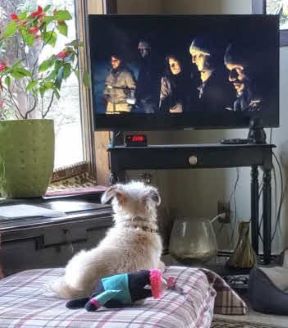Insights from pet owner survey may help veterinary eye doctor develop vision test
Puck Fischer

Photo by Dr. Sarah Fischer
Puck, a 12-year-old Yorkshire-Cairn terrier mix, watches a scene of people being stalked by a wolf.
 Listen to this story.
Listen to this story.
There's a dog who likes to watch cartoons of dogs. One who cowers at the sight of hawks swooping across a screen. Another who's figured out how to operate the television remote and lounges in a recliner, watching while her owner is at work.
Ask "Does your dog watch TV?" and owners chime in with zest, or so Dr. Freya Mowat is finding. A veterinary ophthalmologist at the University of Wisconsin-Madison, Mowat is running a survey online to learn about the screen-watching habits of dogs. Inside of two weeks, the survey has drawn 700 responses worldwide, including from Australia, Brazil, Portugal, Spain and New Zealand. Mowat hopes the survey goes viral.
She readily acknowledges that the subject may seem frivolous but the purpose of the research, she promises, is not. The survey idea traces to the period when Mowat was holed up at home early in the Covid-19 pandemic. In the quiet of lockdown, thinking about research she's doing on aging's effects on dog eyesight, Mowat considered how some pets watch videos or shows on computers or TV. Could that activity, she wondered, be harnessed as a tool for a vision exam?
"What we miss in veterinary medicine is a meaningful way to test vision in pets. ... " she said. "When you go to the eye doctor, you have the eye chart in front of you, and you read the letters until they get too small to read, and that's your limit of visual ability. What we do in vet med is, we wave our hands in the dog's face or cat's face and sort of see if they blink."
Veterinary ophthalmology has more sophisticated techniques for probing various properties of animal vision, but when it comes to determining a dog's (or cat's) ability to see sharply, and at what distance, a quick, easy-to-use tool comparable to the letter chart used for human patients has yet to be invented.
Maybe, Mowat's thinking goes, an assessment could be developed using videos that dogs like to watch. Exactly what that assessment might be is yet to be worked out. Perhaps you'd vary the exposure or contrast of videos, or change the size of an object in a video, she muses. But first questions first: What do dogs like to watch?
Hence, the survey. Posted online late last month, the survey is short (around 25 questions), and includes four optional brief videos that participants may show their pets. To make sure the dogs are responding to sights and not sounds, the videos generally have no audio other than the bleat of a squeaky toy at the beginning of each segment to catch their attention.
After each video, the owner is asked whether their dog watched and tracked the movements in the video, and if so, for how long.
Using video images is an idea Mowat adapted from pediatricians, whose patients, like pets, cannot read or speak in words. Last summer, Mowat's laboratory deployed electronic versions of a tool used with infants, called teller acuity cards. The cards show patterns of stripes, each different from the next, that the doctor waves, one by one, to catch the baby's attention. Well, that may work with babies but not so much with dogs.
A dog "goes 'Ooh' the first time, and it goes 'ooh' the second time, and after that, it's, 'What's in it for me?' " Mowat recounted, declaring the experiment an "epic fail."
The series of videos used in the survey are delivering much more promising results so far. "If the content is right, the dog is super-engaged," Mowat said. "One dog belongs to one of my lab members. He tries to go meet the bird on the screen; it's very cute."
Video courtesy of Dr. Freya Mowat
Watching a screen at the University of Wisconsin-Madison Mowat Lab, Theo tracks a raven as it hops back and forth across grass.
In a recording provided by Mowat showing that cute moment, a Bernese mountain dog named Theo clearly follows the movements of the bird as it hops across the screen. Then Theo leans toward it.
In a comments section of the survey, respondents are invited to tell more about their dogs' watching habits. Some favorite programs and movies, owners report, are Westerns, The Wizard of Oz and 101 Dalmatians.
Reacting to cartoons, commercials and Voldemort
Asked by a reporter whether their dogs watch TV, veterinarians who belong to the Veterinary Information Network, an online community for the profession, replied on a message board with colorful stories.
Dr. Sarah Fischer, a veterinarian in Connecticut, said her 12-year-old terrier mix, Puck, "gets super excited for any animal — live or cartoon, real or imaginary." Puck also reacts to Voldemort, growling every time the Harry Potter villain appears.
Elaborating by email, Fischer said: "He has learnt which commercials have animals in them by their opening sounds, so if he hears the music/etc., he'll come running into the room or start breathing heavily if he's already here. Once he confirms it is the commercial he thinks, he'll start barking. The Farmer's Insurance commercials are his favorite, and you can feel his disappointment when it's not one with animals."
Dr. Jonathan Ford, also in Connecticut, said his dog Muxia, an almost-4-year-old Brussels griffon affectionately known as Moo, mainly is interested in "moving critters, sometimes talking people. Even better if she can lunge at and try to eat them (while slobbering on the screen)."
In Calgary, Alberta, Dr. Kirstin Sprissler's pit bull, Norah, enjoys the television series Border Patrol "because sometimes there are drug dogs in it, [and] even if there are not, she sits attentively and watches the entire episode, just in case."
Generally, Norah likes all shows that have animals, as well as certain cartoons, Sprissler reported — Family Guy is one that she'll watch from beginning to end.
Norah also has distinct dislikes. "She HATES a certain Excel gum commercial, which features a cartoon pizza slice that appears to come towards the screen," Sprissler said. "The first time she saw that, she gave one huge WOOF and then ran and hid under the kitchen table, looking worriedly between me and the screen, apparently wondering why I wasn't saving myself."
Dr. Freya Mowat

University of Wisconsin photo
Dr. Freya Mowat is a veterinary ophthalmologist researching the effects of aging on dogs' eyesight.
Dogs like Norah who watch entire episodes might be an exception. Mowat said survey results so far indicate that most do not watch that long.
The survey will remain online indefinitely — in other words, there's no deadline to join in — but Mowat plans by the end of May to write an abstract of findings for an ophthalmology conference in October.
One question the survey won't be able to answer is what proportion of dogs watch TV or videos. That's because owners whose dogs watch are more apt to do the survey than those whose dogs don't. Mowat said she'll try to answer that question a different way, perhaps by polling a subset of dog owners.
Long-term, by developing a means for assessing dogs' vision, Mowat hopes to add to the tools available for monitoring pets' condition as they get older.
In the same way that human medicine is on the alert to diseases of aging, whether it's cognitive decline or difficulty navigating in the dark, "maybe those types of things are actually something we should start thinking about in our pets, as well," Mowat said.
"Not that we need to establish a whole new field of medicine," she added, "but perhaps [within] our individual specialities, we need to consider the disease of aging or the susceptibility to disease of aging as a component of what we do when we practice medicine."
For this veterinary ophthalmologist, learning more about dogs' TV-watching proclivities is a step toward that end.